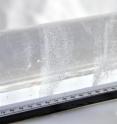Research team draws 150-meter ice core from McCall Glacier
A 150-meter ice core pulled from the McCall Glacier in the Arctic National Wildlife Refuge this summer may offer researchers their first quantitative look at up to two centuries of climate change in the region. The core, which is longer than 11/2 football fields, is the longest extracted from an arctic glacier in the United States, according to Matt Nolan, an associate professor at the University of Alaska Fairbanks Institute of Northern Engineering who has led research at McCall Glacier for the past six years. The sample spans the entire depth of the glacier and may cover 200 years of history, he said.
"What we hope is that the climate record will extend back into the Little Ice Age," said Nolan. "Up until the late 1800s these glaciers were actually growing."
Since then, arctic glaciers have been shrinking at an increasing rate, he said. "There is no doubt that this is due to a change in climate, but until now we can only guess at the magnitude of that change. Within these cores, we will hopefully capture this shift in climate quantitatively, and we're glad to have recovered them now before more of this valuable record melts and flows into the Arctic Ocean."
Ice core samples offer a window into past climate using clues, such as gas bubbles or isotopes of oxygen and hydrogen, locked in the ice when it formed. In addition, debris in the ice, such as layers of volcanic ash and pieces of organic material such as insects, can help scientists draw a timeline through the depth of the glacier.
Because McCall Glacier has been studied extensively since the International Geophysical Year in1957-58, the research history there offers a unique opportunity to compare ice core data with a wealth of related information, such as ice temperature and speed, air temperature and snowfall, and models of how the glacier changes within those parameters. Those comparisons with the modern parts of the ice core can help scientists better understand changes in the older sections, Nolan said.
"Due to its remote location, long-term instrumental climate data here are sparse to nonexistent, so ice cores from this glacier are one of our few means to determine climate variations in this huge region over the past few hundred years," Nolan said. "We are also quite fortunate and privileged to be granted permission for this work. Research at McCall Glacier predates the formation of the refuge and meshes well with scientific aspects of the refuge's mission to conduct long-term ecological research."
A team using a drill from the Ice Core Drilling Service at the University of Wisconsin-Madison pulled the cores from the glacier, one meter at a time, for nearly two weeks straight, despite storms strong enough to break and blow away some of their tents. About midway down, drillers hit an aquifer in the ice, which filled the borehole with water and complicated the drilling effort.
"The drill team did an excellent job of making their tools work in challenging conditions, in particular drilling the last 80 meters of core under water," Nolan said. "This is a very unusual situation for ice coring, as most cores are taken from summits of cold, dry polar ice sheets not warm, flowing valley glaciers."
At 150 meters, drillers hit a rock at what the team believes was the bottom of the glacier, based on radar measurements of ice depth.
The ice cores were flown to Fairbanks and are being housed at the Alaska Ice Art Museum until the fall, when glaciologists will return from the field to begin analysis.
Source: University of Alaska Fairbanks
Other sources
- 150-meter ice core pulled from McCall Glacierfrom Science BlogMon, 14 Jul 2008, 14:25:46 UTC
- Research team draws 150-meter ice core from McCall Glacierfrom PhysorgFri, 11 Jul 2008, 14:14:19 UTC
- 150-meter Ice Core Drawn From McCall Glacier In Arctic National Wildlife Refugefrom Science DailyFri, 11 Jul 2008, 14:14:14 UTC
